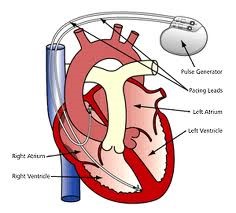The London Atrial Fibrillation (AF) Centre
A pacemaker is an implanted device that monitors your heartbeat and prevents your heart from beating too slowly. It consists of a box (‘generator’) attached to one or two ‘leads’. The generator is usually placed underneath the skin or muscle beneath your collarbone. The lead or leads pass inside the large veins of your chest from the generator to your heart.
The leads transmit information about your heartbeat to the generator. If your heart beats too slowly the pacemaker sends out a tiny electrical impulse to ‘pace’ the heart, i.e. to make it beat at an appropriate speed. If your heart then speeds up again, this is detected by the pacemaker, which then stops pacing your heart.

What does pacemaker implantation involve?
A pacemaker is usually implanted under local anaesthetic. It generally takes ½ to 1 hour, and is performed in our theatres. We will generally perform this under general anaesthetic or heavy sedation. Your heart rhythm, blood pressure and the oxygen level in your blood are monitored continuously. Prof Schilling will put local anaesthetic under the skin below your collar bone so that when you wake up your shoulder is not sore.
An incision about 3-4 cms long is made below the collarbone. The next stage of the procedure is to access one of the veins through which the leads are passed to the heart. Care is taken to find the ideal position for the lead or leads and thorough testing of the leads capacity to measure the heart electrical signals and stimulate the heart is performed. The leads are in the best position, they are then sewn into place and the pacemaker generator is placed in a pocket. This pocket may be overlying or underneath the pectoral muscle. Finally the incision is stitched up. Prof Schilling uses a dissolvable suture so there are no stitches to take out afterwards.
You will then recover in your room before going home.
What to expect after pacemaker implantation
You can expect your shoulder and arm to be sore for a few days afterwards. Simple pain relievers like paracetamol are usually helpful. It is important to keep the arm and shoulder moving, to avoid a ‘frozen shoulder’ but should not lift your arm above your shoulder height. You will not damage your pacemaker by doing so. You should avoid getting the wound wet for about a week after the implant. The wound usually appears a little bruised for several days afterwards. Although the bruising may become more prominent after you go home, any discomfort and redness around the wound should get better rapidly. If you have concerns about the wound it is important that you contact us directly.
Follow-up after pacemaker implantation
After discharge you will be followed up in our pacemaker clinic at around 6 weeks when Prof Schilling will also check that the wound has healed properly. After this visits once a 1 year are arranged. At these visits your pacemaker is checked to make sure that it is working well and to make any adjustments necessary to the way it is programmed. This visit usually lasts about twenty minutes. You should let us know of any changes to your medicines.
Is there anything you should avoid with a pacemaker?
In almost every respect life with a pacemaker is completely normal. Household appliances and mobile telephones do not interfere with your pacemaker’s function and most pacemakers will now allow you to have an MRI scan. The following links are to the websites of three of the major pacemaker manufacturers with useful information for patients about living with a pacemaker:
www.medtronic.com/patients/heart.html
www.guidant.com/webapp/emarketing/compass/comp.jsp?lev1=living&lev2=pace_index
www.sjm.com/procedures/procedure.aspx?name=Pacemaker+Implantation
Driving after a pacemaker
You should not drive for one week (group 1 licences) or 6 weeks (group 2 licences) after pacemaker implantation. You need to inform the DVLA. Up to date rules concerning fitness to drive with heart conditions may be viewed at :
What happens when the battery runs down?
The pacemaker battery behaves in a predictable fashion. By following you up regularly we can predict fairly accurately when the pacemaker generator will need replacing. The pacemaker will be functioning perfectly normally throughout this time and we admit you to replace the generator in a planned fashion. Many factors determine how long a battery will last. Currently available generators typically last about 7-10 years under standard conditions. When the generator is replaced the procedure is similar to that of the original pacemaker implant although we aim to use the original leads and simply attach a new generator.
Can a pacemaker treat AF?
Pacemakers are used to keep the heart rate up. This is not usually a problem with AF but some people will find that even with AF their heart rate can go low enough to cause symptoms of dizzy spells or blackouts. A pacemaker can be used to prevent these symptoms but not stop the AF.
An alternative approach to managing the symptoms from AF is to prevent the AF influencing the heart rhythm by ablating the AV node (a very simple thing to do) and using a pacemaker to simulate normal rhythm. This pacemaker and AV node ablation procedure is a very reliable way of assuring regular heart rhythms and rates and the AF can never influence the heart rhythm again. It is done in 2 steps. The pacemaker is inserted first and then we will usually wait 4-6 weeks to make sure it is working before ablating the AV node and allowing the pacemaker to take over.


